Applying Data Analysis and Machine Learning Methods to Predict Permafrost Coast Erosion
Abstract
:1. Introduction
2. Study Area and Input Data
3. Methods
3.1. Data Preprocessing
3.1.1. Conversion of Categorical Data
3.1.2. Data Normalization
3.1.3. Filling in the Missing Values
3.2. Correlation and Factor Analysis
3.3. Approach to Predicting the Coastline Position
3.3.1. Median Filter and Random Component Estimation
3.3.2. Neural Network Design and Training
4. Results and Discussion
4.1. Correlation and Factor Analysises
4.2. Application of the Median Filter
4.3. Neural Network
5. Conclusions
Author Contributions
Funding
Data Availability Statement
Acknowledgments
Conflicts of Interest
Appendix A

References
- Irrgang, A.M.; Bendixen, M.; Farquharson, L.M.; Baranskaya, A.V.; Erikson, L.H.; Gibbs, A.E.; Ogorodov, S.A.; Overduin, P.P.; Lantuit, H.; Grigoriev, M.N. Drivers, dynamics, and impacts of changing Arctic coasts. Nat. Rev. Earth. Environ. 2022, 3, 39–54. [Google Scholar] [CrossRef]
- Lantuit, H.; Overduin, P.P.; Wetterich, S. Recent progress regarding permafrost coasts. Permafr. Periglac. Process 2013, 24, 120–130. [Google Scholar] [CrossRef]
- Ogorodov, S.; Aleksyutina, D.; Baranskaya, A.; Shabanova, N.; Shilova, O. Coastal Erosion of the Russian Arctic: An Overview. J. Coast. Res. 2020, 95, 599–604. [Google Scholar] [CrossRef]
- Hume, J.D.; Schalk, M.; Hume, P. Short-term climate changes and coastal erosion, Barrow, Alaska. Arctic 1972, 4, 272–278. [Google Scholar] [CrossRef]
- Shabanova, N.; Ogorodov, S.; Shabanov, P.; Baranskaya, A. Hydrometeorological forcing of western Russian Arctic coastal dynamics: XX-century history and current state. Geogr. Environ. Sustain. 2018, 11, 113–129. [Google Scholar] [CrossRef]
- Manson, G.K.; Solomon, S.M. Past and Future Forcing of the Beaufort Sea Coastal Change. Atmos. Ocean 2007, 45, 107–122. [Google Scholar] [CrossRef]
- Henqutte, A.; Desrosiers, M.; Hill, P.R.; Forbes, D.L. The influence of coastal morphology on shoreface sediment transport under storm-combined flows, Canadian Beaufort Sea. J. Coast. Res. 2001, 17, 507–516. [Google Scholar]
- Hopkins, D.M.; Hartz, R.W. Coastal Morphology, Coastal Erosion and Barrier Islands of the Beaufort Sea, Alaska; U.S. Geological Survey Open-File Report 78-106354; U.S. USGS Publications Warehouse Geological Survey: Reston, VA, USA, 1978; p. 54.
- Mackay, J.R. Ice wedge cracks, Garry Island, N.W.T. Can. J. Earth Sci. 1974, 1, 1366–1383. [Google Scholar] [CrossRef]
- Vasiliev, A.A. Permafrost controls of coastal dynamics at the Marre-Sale key site, western Yamal. In Proceedings of the 8th International Conference on Permafrost: Permafrost, Zurich, Switzerland, 20–25 July 2003; Philips, M., Springman, S., Eds.; Swets & Zeitlinger: Lisse, The Netherlands, 2003; Volume 2, pp. 1173–1178. [Google Scholar]
- Lantuit, H.; Pollard, W.H. Temporal stereophotogrammetric analysis of retrogressive thaw slumps on Herschel Island, Yukon Territory. Nat. Hazards Earth Syst. Sci. 2005, 5, 413–423. [Google Scholar] [CrossRef]
- Ogorodov, S.A. Human impacts on coastal stability in the Pechora Sea. Geo-Mar. Lett. 2005, 25, 190–195. [Google Scholar] [CrossRef]
- Jones, B.; Farquharson, L.; Baughman, C.; Buzard, R.; Arp, C.; Grosse, G.; Bull, D.L.; Günther, F.; Nitze, I.; Urban, F.; et al. A decade of remotely sensed observations highlight complex processes linked to coastal permafrost bluff erosion in the Arctic. Environ. Res. Lett. 2018, 1, 38–45. [Google Scholar] [CrossRef]
- Kritsuk, L.N.; Dubrovin, V.A.; Yastreba, N.V. Some results of integrated study of the Kara Sea coastal dynamics in the Marre-Sale meteorological station area, with the use of GIS technologies. Earth’s Cryosphere 2014, 4, 59–69. [Google Scholar]
- Sinitsyn, A.; Guégan, E.; Shabanova, N.; Kokin, O.; Ogorodov, S. Fifty Four Years of Coastal Erosion and Hydrometeorological Parameters in the Varandey Region, Barents Sea. Coast. Eng. 2020, 157, 103610. [Google Scholar] [CrossRef]
- Pizhankova, E.I.; Dobrynina, M.S. The dynamics of the Lyakhovsky Islands coastline (results of aerospace image interpretation). Earth’s Cryosphere 2010, 4, 66–79. [Google Scholar]
- Frederick, J.M.; Thomas, M.A.; Bull, D.L.; Jones, C.; Roberts, J.D. Evaluating Approaches to a Coupled Model for Arctic Coastal Erosion, Infrastructure Risk, and Associated Coastal Hazards; Presented at the AGU Fall Meeting, San Francisco, USA, December 2016; Poster Number EP13C-1043. Available online: https://www.researchgate.net/publication/312167767_Evaluating_Approaches_to_a_Coupled_Model_for_Arctic_Coastal_Erosion_Infrastructure_Risk_and_Associated_Coastal_Hazards (accessed on 15 October 2024).
- Leont’ev, I.O. Modeling the evolution of the Accumulative Shores of the Barents and Kara Seas. Geomorphologiay 2002, 1, 53–64. (In Russian) [Google Scholar]
- Leont’ev, I.O. Modeling the evolution of Russian Arctic Shorelines. Oceanologiya 2004, 44, 457–468. (in Russian). [Google Scholar]
- Pavlidis, Y.A.; Leont’ev, I.O. Prognosis of East Siberian shore development on the increase of sea level and climatic change. Bull. RFBR 2002, 4, 53–57. (In Russian) [Google Scholar]
- Razumov, S.O. Thermal abrasion rate of sea coasts as a function of the climatic and morphological characteristics of the coast. Geomorphologiya 2000, 3, 88–94. (In Russian) [Google Scholar]
- Razumov, S.O. Modeling of the coastal erosion of the Arctic seas in changing climatic conditions. Kriosf. Zemli 2001, 1, 53–60. (In Russian) [Google Scholar]
- Kobayashi, N. Formation of thermoerosional niches into frozen bluffs due to storm surges on the Beaufort Sea Coast. J. Geophys. Res. 1985, 90, 11983–11988. [Google Scholar] [CrossRef]
- White, F.M.; Spaulding, M.L.; Gominho, L. Theoretical Examples of the Various Mechanisms Involved in Iceberg Deterioration in the Open Ocean Environment; Technical Report; National Technical Information Service Publication: Springfield, VA, USA, 1980.
- Russell-Head, D.D. The melting of free-drifting icebergs. Ann. Glaciol. 1980, 1, 119–122. [Google Scholar] [CrossRef]
- Holland, P.R.; Jenkins, A.; Holland, D.M. The response of ice shelf basal melting to variations in ocean temperature. J. Clim. 2008, 21, 2558–2572. [Google Scholar] [CrossRef]
- Kobayashi, N.; Aktan, D. Thermoerosion of frozen sediment under wave attack. J. Waterw. Port Coast. Ocean. Eng. 1986, 112, 140–158. [Google Scholar] [CrossRef]
- Kobayashi, N.; Vidrine, J. Combined Thermal-Mechanical Erosion Processes Model; Research Report No. CACR-95-12; Center for Applied Coastal Research: Newark, DE, USA, 1995.
- Baird & Associates. Development of a Model for the Thermal-Mechanical Erosion on Arctic Coasts; Final report prepared for Geological Survey of Canada; Geological Survey of Canada: Oakville, ON, Canada, 1995.
- Zhang, W.; Witharana, C.; Liljedahl, A.K.; Kanevskiy, M. Deep Convolutional Neural Networks for Automated Characterization of Arctic Ice-Wedge Polygons in Very High Spatial Resolution Aerial Imagery. Remote Sens. 2018, 10, 1487. [Google Scholar] [CrossRef]
- Huang, L.; Liu, L.; Jiang, L.; Zhang, T. Automatic Mapping of Thermokarst Landforms from Remote Sensing Images Using Deep Learning: A Case Study in the Northeastern Tibetan Plateau. Remote Sens. 2018, 10, 2067. [Google Scholar] [CrossRef]
- Campbell, S.W.; Briggs, M.; Roy, S.G.; Douglas, T.A.; Saari, S. Ground-penetrating radar, electromagnetic induction, terrain, and vegetation observations coupled with machine learning to map permafrost distribution at Twelvemile Lake, Alaska. Permafr. Periglac. Process 2021, 32, 407–426. [Google Scholar] [CrossRef]
- Aryal, B.; Escarzaga, S.M.; Vargas Zesati, S.A.; Velez-Reyes, M.; Fuentes, O.; Tweedie, C. Semi-Automated Semantic Segmentation of Arctic Shorelines Using Very High-Resolution Airborne Imagery, Spectral Indices and Weakly Supervised Machine Learning Approaches. Remote Sens. 2021, 13, 4572. [Google Scholar] [CrossRef]
- Peponi, A.; Morgado, P.; Trindade, J. Combining Artificial Neural Networks and GIS Fundamentals for Coastal Erosion Prediction Modeling. Sustainability 2019, 11, 975. [Google Scholar] [CrossRef]
- Fogarin, S.; Zanetti, M.; Dal Barco, M.K.; Zennaro, F.; Furlan, E.; Torresan, S.; Critto, A. Combining remote sensing analysis with machine learning to evaluate short-term coastal evolution trend in the shoreline of Venice. Sci. Total Environ. 2023, 859, 160293. [Google Scholar] [CrossRef]
- Chen, C.; Zhang, C.; Tian, B.; Wu, W.; Zhou, Y. Mapping intertidal topographic changes in a highly turbid estuary using dense Sentinel-2 time series with deep learning. ISPRS J. Photogramm. Remote Sens. 2023, 205, 1–16. [Google Scholar] [CrossRef]
- Kazhukalo, G.; Novikova, A.; Shabanova, N.; Drugov, M.; Myslenkov, S.; Shabanov, P.; Belova, N.; Ogorodov, S. Coastal Dynamics at Kharasavey Key Site, Kara Sea, Based on Remote Sensing Data. Remote Sens. 2023, 15, 4199. [Google Scholar] [CrossRef]
- Philipp, M.; Dietz, A.; Ullmann, T.; Kuenzer, C. Automated Extraction of Annual Erosion Rates for Arctic Permafrost Coasts Using Sentinel-1, Deep Learning, and Change Vector Analysis. Remote Sens. 2022, 14, 3656. [Google Scholar] [CrossRef]
- Boak, E.H.; Turner, I.L. Shoreline Definition and Detection: A Review. J. Coast. Res. 2005, 21, 688–703. [Google Scholar] [CrossRef]
- Reimnitz, E.; Are, F.E. Coastal Bluff and Shoreface Comparison over 34 Years Indicates Large Supply of Erosion Products to Arctic Seas. Polarforschung 2000, 68, 231–356. [Google Scholar]
- Günther, F.; Overduin, P.P.; Sandakov, A.V.; Grosse, G.; Grigoriev, M.N. Short- and long-term thermo-erosion of ice-rich permafrost coasts in the Laptev Sea region. Biogeosciences 2013, 10, 4297–4318. [Google Scholar] [CrossRef]
- Are, F.E. Coastal Erosion of the Arctic Lowlands; Academic Publishing House “Geo”: Novosibirsk, Russia, 2012; p. 291. ISBN 978-5-904682-70-5. (In Russian) [Google Scholar]
- Zhigarev, L.A. Thermal Denudational Processes and Deformation Behavior of Thawing Grounds; Nauka Press: Moscow, Russia, 1975; p. 110. (In Russian) [Google Scholar]
- Serreze, M.C.; Walsh, J.E.; Chapin, F.S.; Osterkamp, T.; Dyurgerov, M.; Romanovsky, V.; Oechel, W.C.; Morison, J.; Zhang, T.; Barry, R.G. Observational Evidence of Recent Change in the Northern High-Latitude Environment. Clim. Change 2000, 46, 159–207. [Google Scholar] [CrossRef]
- Landrum, L.; Holland, M.M. Extremes become routine in an emerging new Arctic. Nat. Clim. Change 2020, 10, 1108–1115. [Google Scholar] [CrossRef]
- National Snow and Ice Data Center. Available online: https://nsidc.org/ (accessed on 12 September 2024).
- Ogorodov, S.A.; Baranskaya, A.V.; Belova, N.G.; Kamalov, A.M.; Kuznetsov, D.E.; Overduin, P.; Shabanova, N.N.; Vergun, A.P. Coastal Dynamics of the Pechora and Kara Seas Under Changing Climatic Conditions and Human Disturbances. Geogr. Environ. Sustain. 2016, 3, 53–73. [Google Scholar] [CrossRef]
- Nicu, I.C.; Tanyas, H.; Rubensdotter, L.; Lombardo, L. A glimpse into the northernmost thermo-erosion gullies in Svalbard archipelago and their implications for Arctic cultural heritage. Catena 2022, 212, 106105. [Google Scholar] [CrossRef]
- Romanovsky, N.N. Fundamentals of Cryogenesis in the Lithosphere; Moscow University Press: Moscow, Russia, 1993; p. 336. (In Russian) [Google Scholar]
- Mason, O.K.; Jordan, J.W.; Lestak, L.; Manley, W.F. Narratives of Shoreline Erosion and Protection at Shishmaref, Alaska: The Anecdotal and the Analytical. In Pitfalls of Shoreline Stabilization; Cooper, J., Pilkey, O., Eds.; Springer: Dordrecht, The Netherlands, 2012; Volume 3, Coastal Research Library. [Google Scholar] [CrossRef]
- Bogatova, D.; Buldovich, S.; Khilimonyuk, V. Snow Patches and Their Influence on Coastal Erosion at Baydaratskaya Bay Coast, Kara Sea, Russian Arctic. Water 2021, 13, 1432. [Google Scholar] [CrossRef]
- Bogatova, D.; Ogorodov, S.A. Formalization for Subsequent Computer Processing of Kara Sea Coastline Data. Data 2024, 9, 145. [Google Scholar] [CrossRef]
- Kruglova, E.E.; Myslenkov, S.A. Analysis of storm activity in the Kara Sea according to the wave model WAVE WATCH III. J. Hydrometeorol. Ecol. 2022, 69, 675–690. (In Russian) [Google Scholar] [CrossRef]
- Baydaratskaya Bay Environmental Conditions. The Basic Results of Studies for the Pipeline "Yamal-Center" Underwater Crossing Design; Publishing House GEOS: Moscow, Russia, 1997; p. 432. ISBN 5-89118-008-1. (In Russian) [Google Scholar]
- Romanenko, F.A.; Belova, N.G.; Nikolaev, V.I.; Olyunina, O.S. Sediments of the Yugorsky coast of Baydaratskaya Bay, Kara Sea. In Proceedings of the Fifth All-Russian Quaternary Conference, Moscow, Russia, 7–9 November 2007; Publishing House GEOS: Moscow, Russia, 2007; pp. 348–351, ISBN 978-5-89118-401-5. (In Russian). [Google Scholar]
- Aleksyutina, D.; Motenko, R. Composition, structure and properties of frozen and thawed deposits on the Bayadaratskaya Bay coast, Kara Sea. Earth’s Cryosphere 2017, 21, 11–22. [Google Scholar]
- Kizyakov, A.I.; Leibman, M.O.; Perednya, D.D. Destructive relief-forming processes at the coasts of the Arctic plains with tabular ground ice. Earth’s Cryosphere 2006, 2, 79–89. (In Russian) [Google Scholar]
- Belova, N. Ground ice and its’ influence on coastal erosion of Kara Sea region, Russian Arctic. In Proceedings of the 18th International Multidisciplinary Scientific GeoConference SGEM2018, Informatics, Geoinformatics and Remote Sensing, Albena, Bulgaria, 2–8 July 2018; SGEM: Sofia, Bulgaria, 2018; Volume 18, pp. 173–179. [Google Scholar]
- Bogatova, D.; Baranskaya, A.; Belova, N.; Ogorodov, S. The role of permafrost processes in the coastal dynamics of the Kara Sea. In Proceedings of the 26th International Conference on Port and Ocean Engineering Under Arctic Conditions, Moscow, Russia, 14–18 June 2021. [Google Scholar]
- Pant, J.; Pant, R.P.; Singh, M.K.; Singh, D.P.; Pant, H. Analysis of agricultural crop yield prediction using statistical techniques of machine learning. Mater. Today Proc. 2021, 46, 10922–10926. [Google Scholar] [CrossRef]
- Kim, S.; Kim, K.H.; Lim, J.T. Synergistic enhancement of productivity prediction using machine learning and integrated data from six shale basins of the USA. Geoenergy Sci. Eng. 2023, 229, 212068. [Google Scholar] [CrossRef]
- OneHotEncoder Modules. Available online: https://scikit-learn.org/dev/modules/generated/sklearn.preprocessing.OneHotEncoder.html (accessed on 10 June 2024).
- Grigoriev, M.N.; Razumov, S.O.; Kunitzkiy, V.V.; Spektor, V.B. Dynamics of the Russian East Arctic Sea coasts: Major factors, regularities and tendencies. Earth’s Cryosphere 2006, 4, 74–95. (In Russian) [Google Scholar]
- Aleksyutina, D.; Belova, N.; Baranskaya, A.; Ogorodov, S. Morphological and permafrost factors of coastal dynamics at Kara sea. In Proceedings of the 14th International MEDCOAST Congress on Coastal and Marine Sciences, Engineering, Management and Conservation, Marmaris, Turkey, 22–26 October 2019; Volume 2, pp. 639–649. [Google Scholar]
- Aleksyutina, D.M.; Shabanova, N.N.; Kokin, O.V.; Vergun, A.P.; Novikova, A.V.; Ogorodov, S.A. Monitoring and modelling issues of the thermoabrasive coastal dynamics. IOP Conf. Ser. Earth Environ. Sci. 2018, 193, 012003. [Google Scholar] [CrossRef]
- Jin, X.; Zhang, J.; Kong, J.; Su, T.; Bai, Y. A Reversible Automatic Selection Normalization (RASN) Deep Network for Predicting in the Smart Agriculture System. Agronomy 2022, 12, 591. [Google Scholar] [CrossRef]
- Pandas. Available online: https://pandas.pydata.org/docs/reference/api/pandas.DataFrame.interpolate.html (accessed on 16 July 2024).
- SciPy. Available online: https://docs.scipy.org/doc/scipy/reference/generated/scipy.stats.chi2_contingency.html (accessed on 18 July 2024).
- FactorAnalyzer. Available online: https://factor-analyzer.readthedocs.io/en/latest/factor_analyzer.html#factor-analyzer-api (accessed on 5 September 2024).
- Keras. Available online: https://keras.io/ (accessed on 15 October 2024).
- Kopa-Ovdienko, N.V.; Ogorodov, S.A. Peculiarities of dynamics of thermoabrasion coasts of Baydaratskaya Bay (Kara Sea) today. Geomorphol. RAS 2016, 3, 12–21. (In Russian) [Google Scholar] [CrossRef]
- Isaev, V.; Koshurnikov, A.; Pogorelov, A.; Amangurov, R.; Podchasov, O.; Sergeev, D.; Buldovich, S.; Aleksyutina, D.; Grishakina, E.; Kioka, A. Cliff retreat of permafrost coast in south-west Baydaratskaya Bay, Kara Sea, during 2005–2016. Permafr. Periglac. Process. 2019, 30, 35–47. [Google Scholar] [CrossRef]
- Sovershaev, V.A. Tasks of coastal study in the permafrost zone for the purpose of rational economic development. In Proceedings of the Second Conference of Geokryologists in Russia, Moscow, Russia, 3–5 June 1996; Moscow University Press: Moscow, Russia, 1996; Volume 3, pp. 494–503. (In Russian). [Google Scholar]
- Pullman, E.R.; Jorgenson, M.T.; Shur, Y. Thaw Settlement in Soils of the Arctic Coastal Plain, Alaska. Arct. Antarct. Alp. Res. 2007, 39, 468–476. [Google Scholar] [CrossRef]
- Wolfe, S.A.; Dallimore, S.R.; Solomon, S.M. Coastal permafrost investigations along a rapidly eroding shoreline, Tuktoyaktuk, N.W.T. In Proceedings of the 7th International Conference on Permafrost, Yellowknife, NWT, Canada, 23–27 June 1998; pp. 1125–1131. [Google Scholar]
- Romanovskii, N.N.; Tumskoy, V.E. Retrospective approach to the estimation of the contemporary extension and structure of the shelf cryolithozone in East Arctic. Earth’s Cryosphere 2011, 1, 85–97. (In Russian) [Google Scholar]
- Jones, B.M.; Kenneth, M.; Hinkel, K.M.; Arp, C.D.; Wendy, R. Eisner Modern erosion rates and loss of coastal features and sites, Beaufort Sea coastline, Alaska. Arctic 2008, 61, 361–372. [Google Scholar]
- Reimnitz, E.; Maurer, D.K. Effects of storm surges on the Beaufort Sea coast, northern Alaska. Arctic 1979, 32, 329–344. [Google Scholar] [CrossRef]
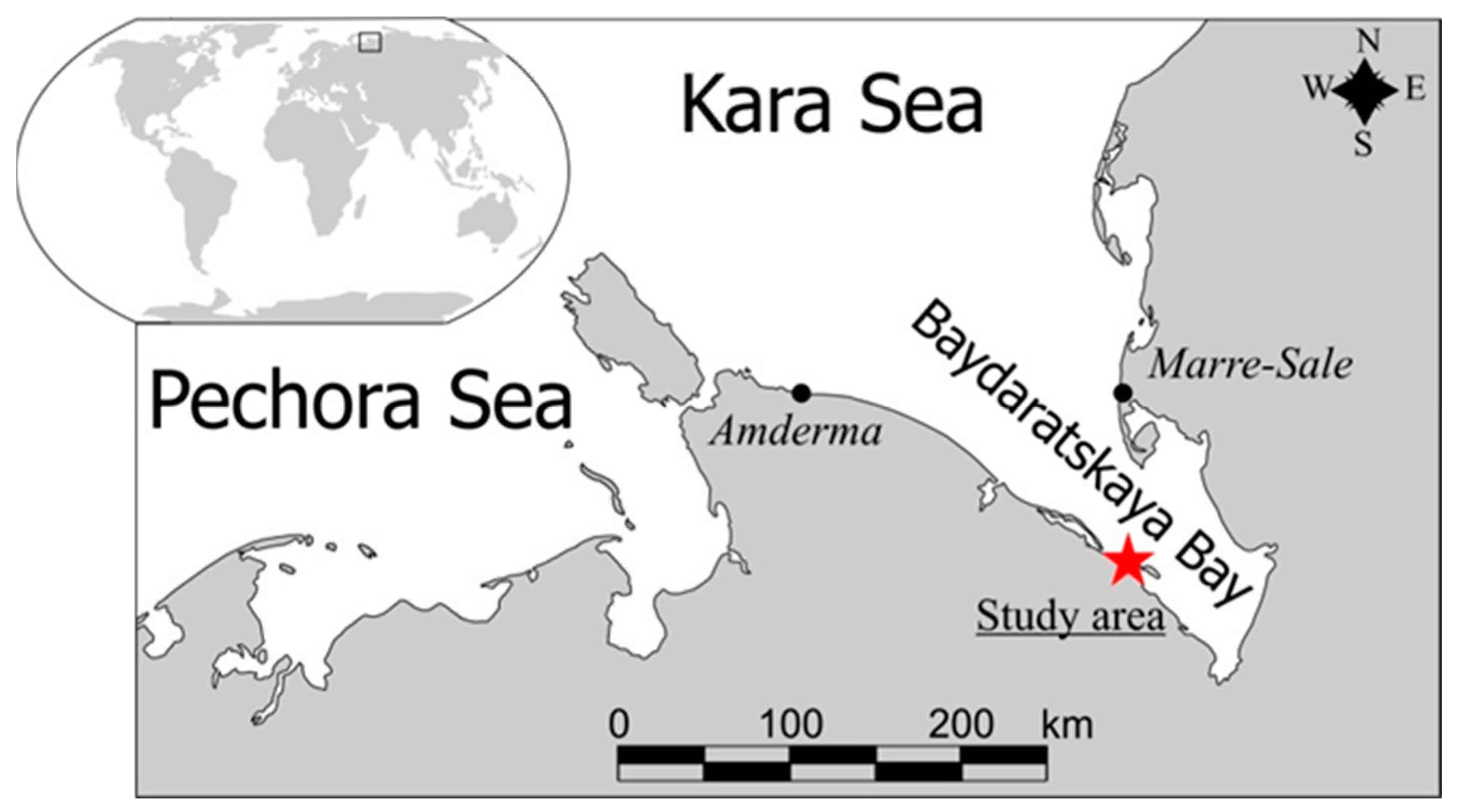

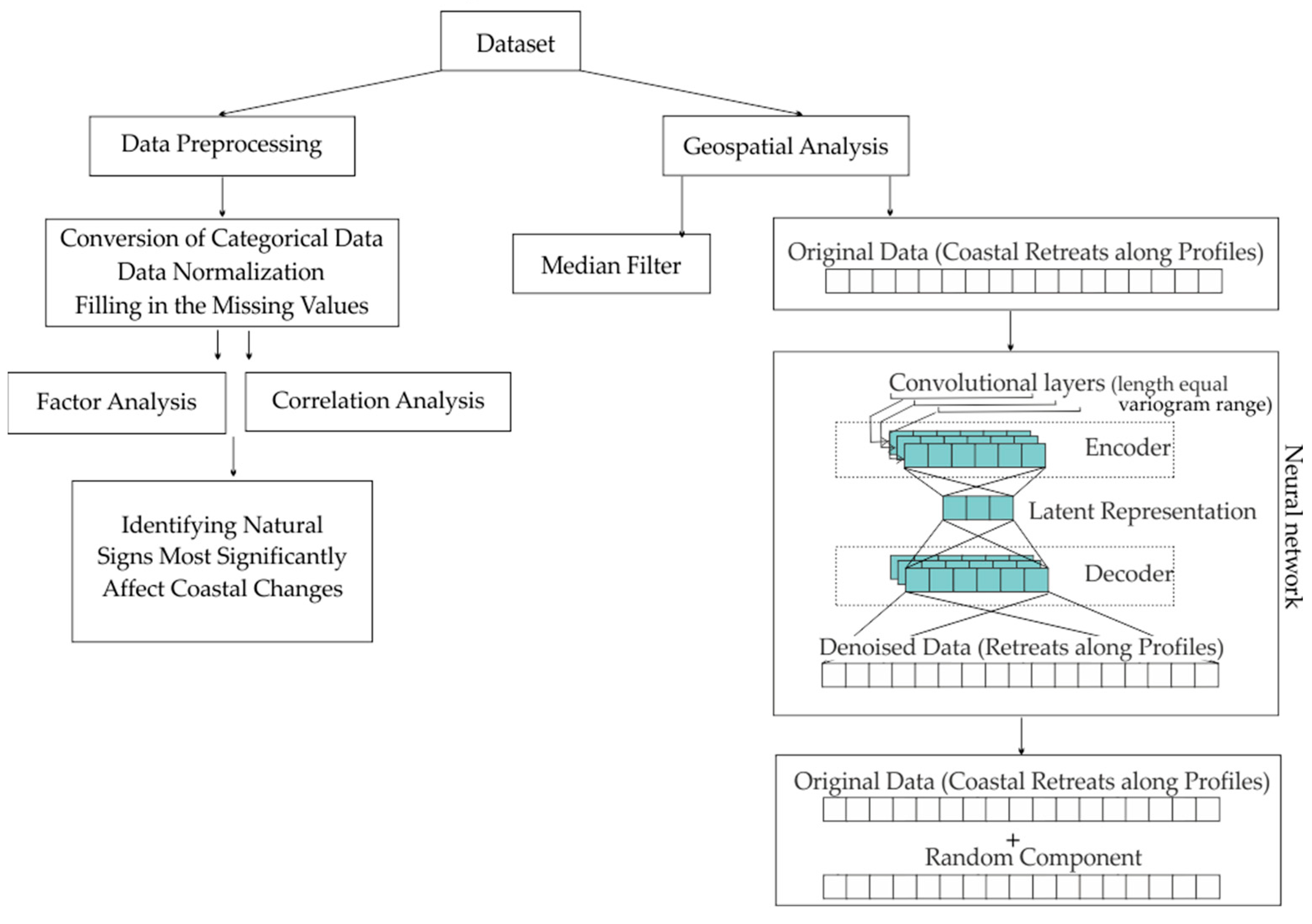

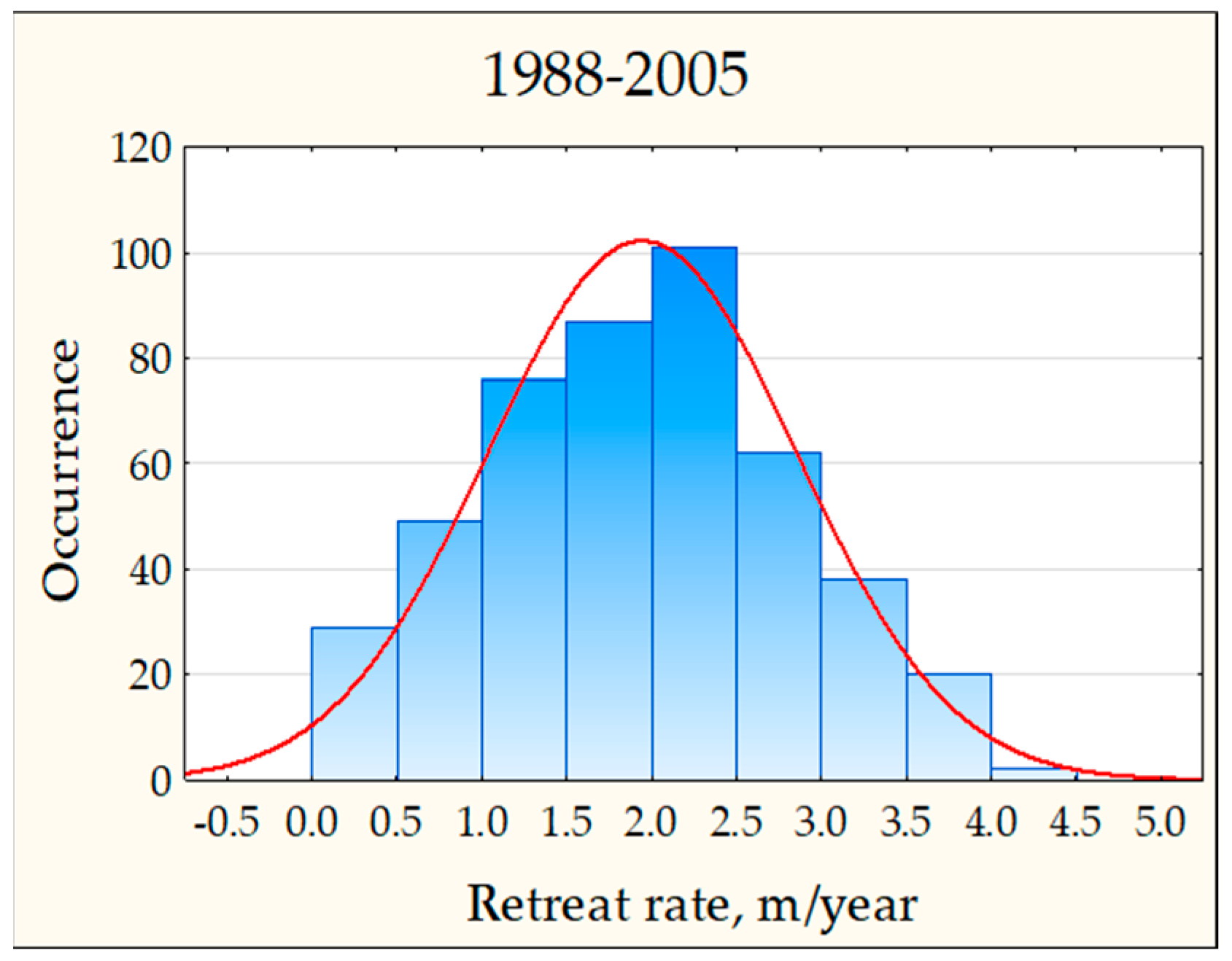
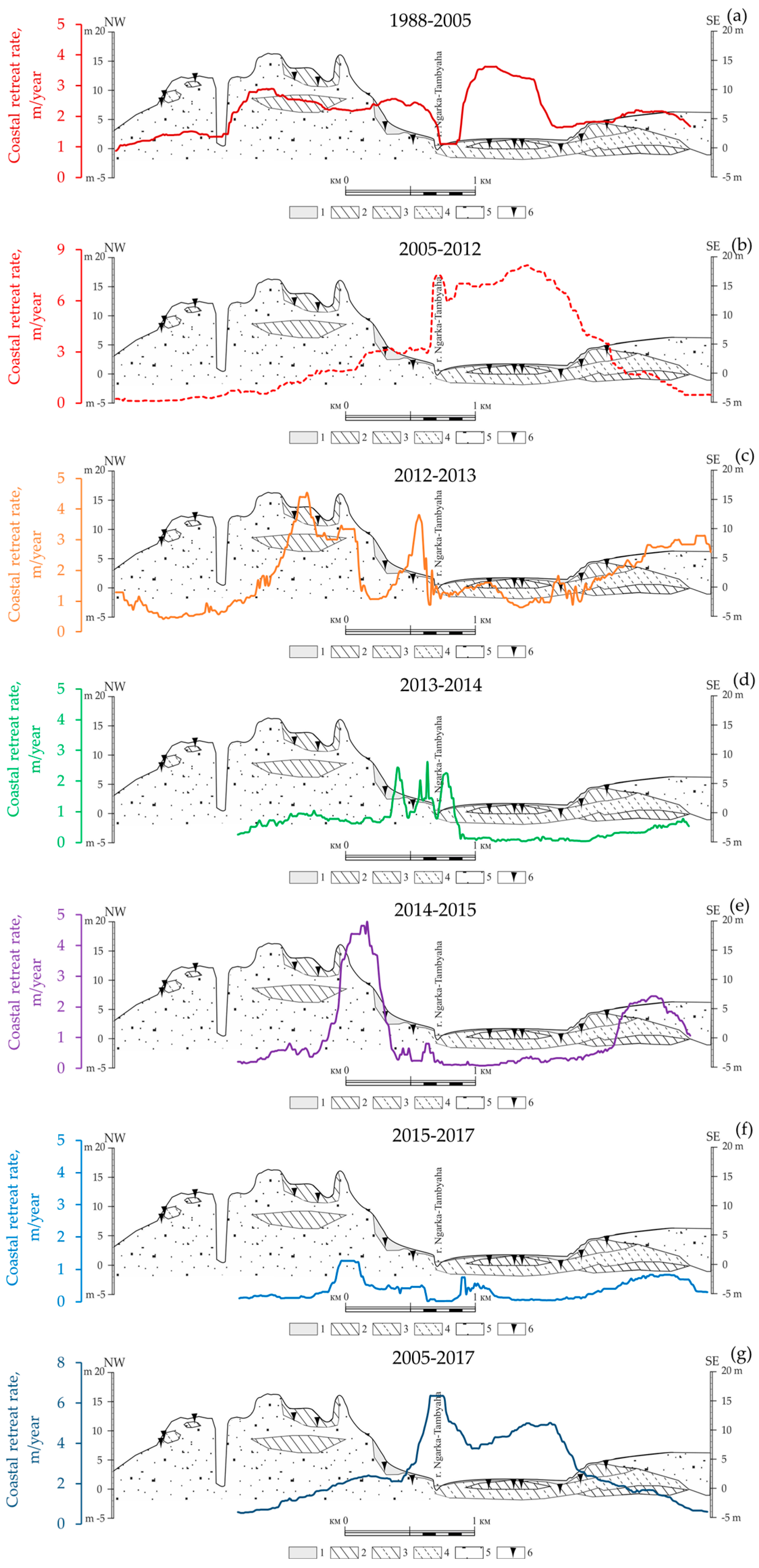

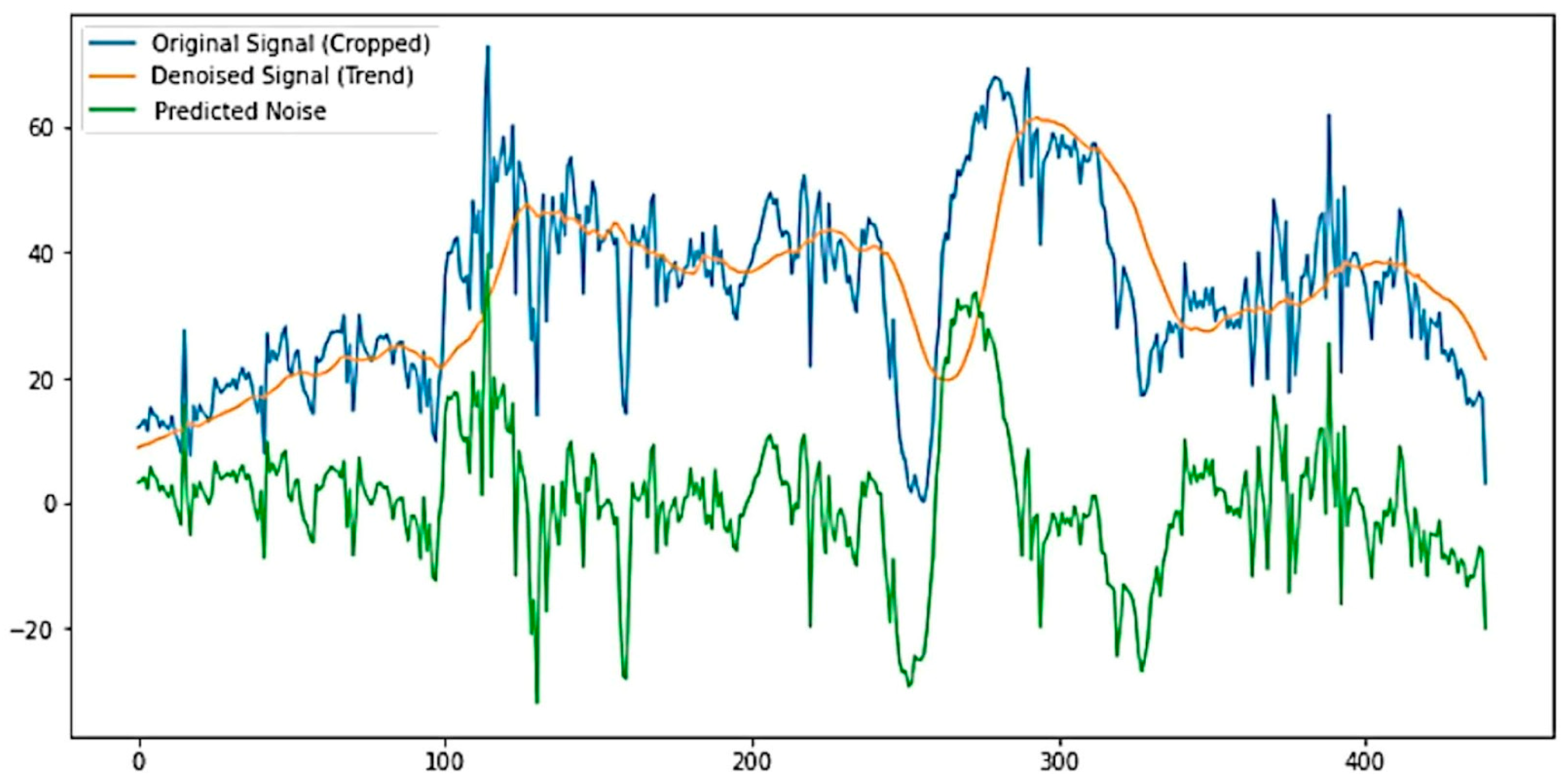

| Column | Description | |
|---|---|---|
| S_Area | Study area: 1—Ural coast | |
| Morpho | Morphological level: 1—laida (up to 4m); 2—low surface from 4 to 9 m; 3—high surface from 9 to 15 m | |
| Average cliff height | Cliff height, m. | |
| Permafrost processes | Predominant permafrost processes: | 1–Thermodenudation |
| 2–Thermal abrasion | ||
| 3–Thermal-erosion gullies | ||
| 4–Thermokarst | ||
| Lithology | Lithology type: | 1–Sands |
| 2–Loams | ||
| 3–Sands and loams | ||
| 4–Peat | ||
| VT | Virtual transect number | |
| No_WE | Transect’s numbers from west to east | |
| Ret YEAR-YEAR | Coastal retreat during time slices (chosen YEAR), meter | |
| Y YEAR | Longitude coordinate of bluff position in chosen YEAR | |
| X YEAR | Latitude coordinate of bluff position in chosen YEAR | |
| VR YEAR-YEAR | Coastal retreat rate during time slices, meter/year | |
| Categorical Data | Correlation Coefficient | p-Value | Interpretation/Description | |
|---|---|---|---|---|
| Laida | 0.398 | 0 | Moderate positive | Significant |
| Low surface | −0.034 | 0.47 | Very weak | Not significant |
| High surface | −0.324 | 0 | Weak | Significant |
| Thermodenudation | −0.508 | 0 | Moderate negative | Significant |
| Thermal abrasion | 0.247 | 0 | Weak | Significant |
| Thermal erosion | 0.152 | 0 | Very weak | Significant |
| Thermokarst | 0.406 | 0 | Moderate positive | Significant |
| Sands | −0.453 | 0 | Moderate negative | Significant |
| Loams | 0.355 | 0 | Moderate positive | Significant |
| Sands and loams | 0.182 | 0 | Very weak | Significant |
| Peats | 0.024 | 0.6 | Very weak | Not significant |
| Categorical Data | Categorical Data | Correlation Coefficient |
|---|---|---|
| Geomorphological level | Predominant permafrost processes | 0.689 |
| Geomorphological level | Sediments composition | 0.545 |
| Predominant permafrost processes | Sediments composition | 0.583 |
| Parameter | Time Interval | Number of Transects | Max Value | Min Value | Mean | Variance | Standard Deviation |
|---|---|---|---|---|---|---|---|
| Random component in the data, m/year | 1988–2005 | 433 | 1.5 | −2.1 | 0.0 | 0.2 | 0.4 |
| 2005–2012 | 428 | 11.2 | −5.9 | 0.1 | 2.3 | 1.5 | |
| 2005–2017 | 330 | 4.9 | −6.4 | 0.0 | 1.0 | 1.0 | |
| 2012–2013 | 376 | 17.4 | −3.6 | 0.3 | 3.2 | 1.8 | |
| 2013–2014 | 236 | 16.0 | −2.4 | 0.5 | 4.1 | 2.0 | |
| 2014–2015 | 237 | 5.8 | −3.9 | 0.3 | 1.3 | 1.2 | |
| 2015–2017 | 244 | 4.0 | −0.8 | 0.2 | 0.5 | 0.7 |
| Signs That Have Positive Correlations 1 | Signs That Have No Significant Correlations 1 | Signs That Have Negative Correlations 1 |
|---|---|---|
| Laida (0.398) | Low surface (−0.034) | High surface (−0.324) |
| Thermokarst (0.409) Thermal abrasion (0.247) | Therma erosion (0.152) | Thermodenudation (−0.508) |
| Loams (0.355) | Sands and loams (0.182) Peats (0.024) | Sands (−0.453) |
| Variables of Coast | 1988−2005 | 2005−2012 | 2005−2017 | ||||||
|---|---|---|---|---|---|---|---|---|---|
| F1 | F2 | F3 | F1 | F2 | F3 | F1 | F2 | F3 | |
| Laida | 0.63 | 0.52 | 0.45 | 0.68 | 0.47 | 0.22 | 0.71 | 0.47 | −0.01 |
| Low surface | −0.45 | −0.20 | 0.44 | −0.23 | −0.23 | 0.61 | 0.01 | −0.25 | −0.73 |
| High surface | 0.04 | −0.16 | −0.74 | −0.23 | −0.10 | −0.78 | −0.51 | −0.07 | 0.78 |
| Thermodenudation development | −0.56 | −0.27 | 0.44 | −0.38 | −0.27 | 0.64 | −0.19 | −0.28 | −0.77 |
| Thermal abrasion development | −0.12 | 1.01 | 0.09 | −0.16 | 1.04 | 0.01 | −0.07 | 1.00 | 0.04 |
| Thermal erosion development | 0.14 | −0.09 | −0.81 | −0.09 | −0.06 | −0.85 | −0.29 | −0.05 | 0.81 |
| Thermokarst development | 0.91 | −0.27 | 0.51 | 0.98 | −0.33 | 0.29 | 0.91 | −0.28 | −0.06 |
| Composed of sands | −0.62 | −0.12 | 0.16 | −0.54 | −0.09 | 0.34 | −0.41 | −0.10 | −0.49 |
| Composed of loams | 0.71 | −0.29 | −0.13 | 0.65 | −0.33 | −0.29 | 0.43 | −0.29 | 0.45 |
| Composed of sands and loams | −0.13 | 0.93 | 0.07 | −0.18 | 0.97 | 0.00 | −0.09 | 0.94 | 0.04 |
| Composed of peats | −0.02 | 0.00 | −0.12 | −0.02 | −0.01 | −0.09 | 0.02 | −0.02 | 0.06 |
| Coastal retreat | 0.55 | −0.01 | 0.01 | 0.74 | 0.27 | 0.30 | 0.66 | 0.33 | −0.08 |
Disclaimer/Publisher’s Note: The statements, opinions and data contained in all publications are solely those of the individual author(s) and contributor(s) and not of MDPI and/or the editor(s). MDPI and/or the editor(s) disclaim responsibility for any injury to people or property resulting from any ideas, methods, instructions or products referred to in the content. |
© 2024 by the authors. Licensee MDPI, Basel, Switzerland. This article is an open access article distributed under the terms and conditions of the Creative Commons Attribution (CC BY) license (https://creativecommons.org/licenses/by/4.0/).
Share and Cite
Bogatova, D.; Ogorodov, S. Applying Data Analysis and Machine Learning Methods to Predict Permafrost Coast Erosion. Geosciences 2025, 15, 2. https://doi.org/10.3390/geosciences15010002
Bogatova D, Ogorodov S. Applying Data Analysis and Machine Learning Methods to Predict Permafrost Coast Erosion. Geosciences. 2025; 15(1):2. https://doi.org/10.3390/geosciences15010002
Chicago/Turabian StyleBogatova, Daria, and Stanislav Ogorodov. 2025. "Applying Data Analysis and Machine Learning Methods to Predict Permafrost Coast Erosion" Geosciences 15, no. 1: 2. https://doi.org/10.3390/geosciences15010002
APA StyleBogatova, D., & Ogorodov, S. (2025). Applying Data Analysis and Machine Learning Methods to Predict Permafrost Coast Erosion. Geosciences, 15(1), 2. https://doi.org/10.3390/geosciences15010002







